
Friday, April 14, 2014
My wife’s car spent a good portion of its winter sheltered on a lift at Durand Chevrolet, so I wasn’t very surprised to see a letter from them arrive the other day. It only took a fraction of a second to figure out they were just trying to get her back in the showroom to sell her a new car. It took just a few seconds longer to realize that it wasn’t just an obvious ploy, but an outright fabrication.
First, note the date it was processed by the post office:

April 10, 2014. Comparing that to the date the suposed email was sent/printed:
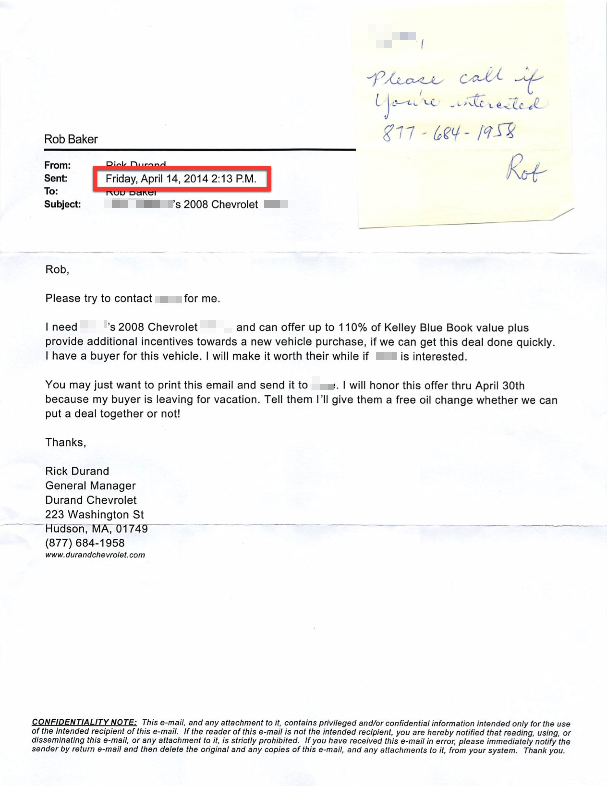
April 14, 2014. Unless GM is now selling time machines, this is impossible - the letter was processed four days before that email was written. My favorite detail is the day of the week. April 14 is a Monday this year, not a Friday. I would have assumed they were using a program specifically tailored to crank out these letters, but that detail makes me think someone just tweaked a Word document by hand.
I find the sloppiness more insulting that the obviously deceptive sales pitch. Rob Baker probably won’t be getting any business from us (and not just because we’re not in the market for a car…).
The Wrong Tool for Writing
I was trying to explain to a friend why I hate the experience of writing in Microsoft Word. I couldn’t convey it last night, but thinking about it this morning I believe it has to do with the extent to which the tool gets in the way of the writing. There’s so much to manage in Word that I find it hard to focus on my writing1. Instead, I end up in an epic battle of paragraph, character, and style formats that feels more like a war of attrition than an enjoyable task.
I went looking for an image I remembered from David Pogue’s 2006 TED Talk, Simplicity Sells. I think this represents my problem with Word perfectly:
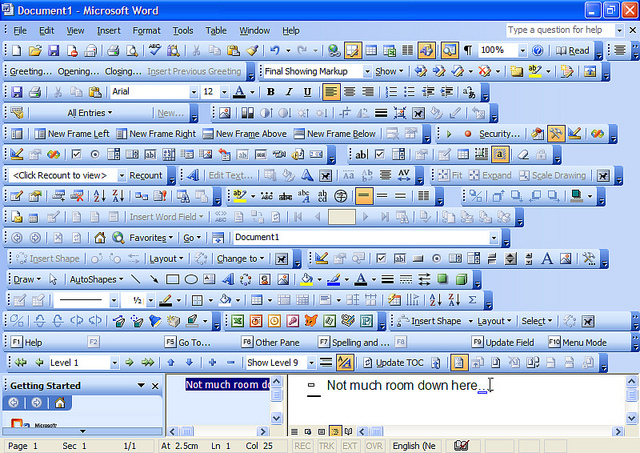
Image credit to Jono Bacon
That’s taken to an absurd level, but even with just a few menus showing I have an ominous sense that I’m using the wrong tool. In contrast, a tool like Byword just feels out of the way. I’m able focus on the text without worrying about whatever it is all those menus do in Word.
-
When you need a 408-page For Dummies book to understand your word processor, I’m inclined to think the tool may be overkill for the job. ↩
Sleep Studies - Last Leaves
My band, Sleep Studies, finally released some songs we’ve been working on for years. Check them out! You can stream or purchase them from Bandcamp.
Screen Sharing with Messages
Over the holidays I’ve spent a lot of time doing tech support for family. After showing a few people how to setup screen sharing via Messages (née iChat), I figured I should document the process1.
You need to start Messages. If your computer is running OS X 10.7.x or earlier, this program is called iChat. I’ll just call it Messages from here in, but know that I mean iChat if you’re on an older operating system.
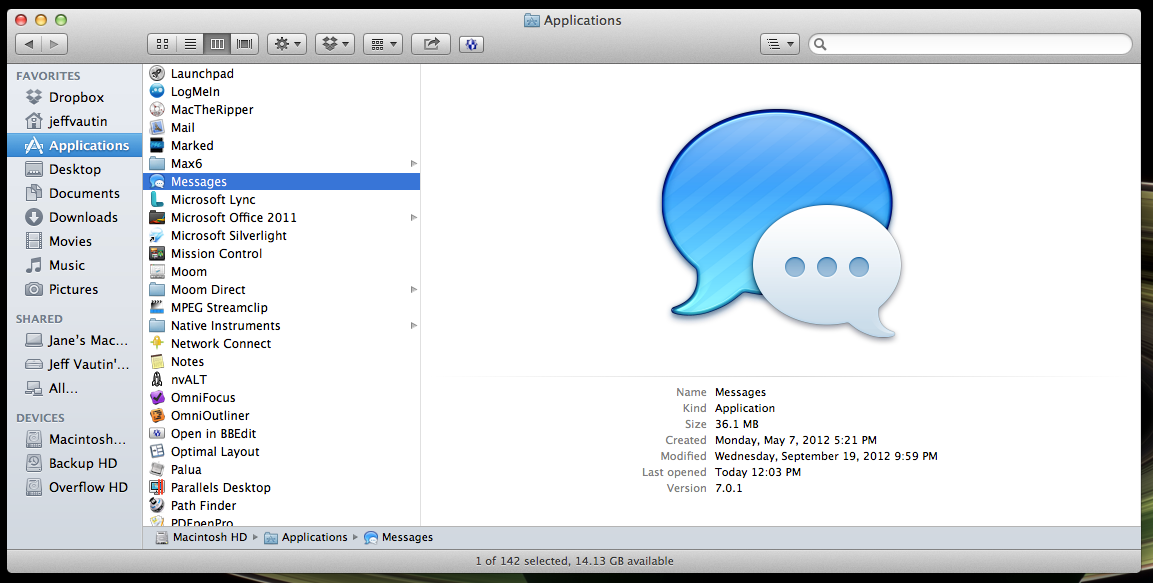
Once you’re in Messages (or iChat), you should make sure the person you want to share your screen with is in your buddy list. If they’re not, you can find instructions for that here. In the worst case you might not have an instant messaging account setup; there are instructions for that here.
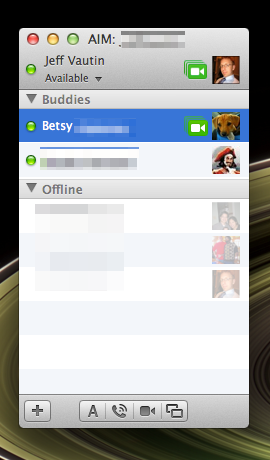
Open the context menu for the person you’d like to share your screen with. You can do this by holding the control key (^) while clicking, or by clicking with two fingers. In the context menu, select ‘Share My Screen with [name]…’.
![In the context menu, select Share My Screen with [name]…](/wp-content/uploads/2012/12/2012-12-30_screen_sharing_step03.png)
The person you’re sharing your screen with will see a notification pop up that’s inviting them to view your screen. They’ll click the notification and accept your invitation.
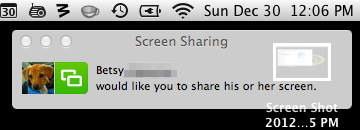
Now you’re sharing your screen. The person on the other end2 will be able to control your screen and can help you figure out whatever you’re having trouble with.
Once you’re finished3, you’ll need to end the screen sharing:
Bring up the context menu for the person you’re sharing with (hold the control button while clicking their name), and select ‘End Screen Sharing’.
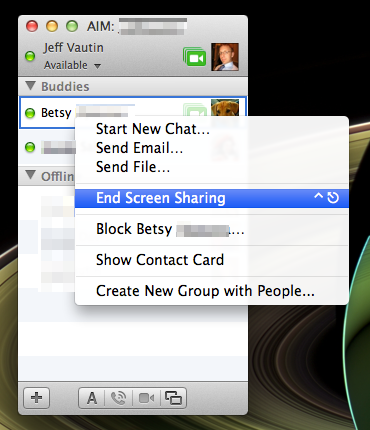
That’s the whole operation.
Full Screen Shortcuts for Omnifocus
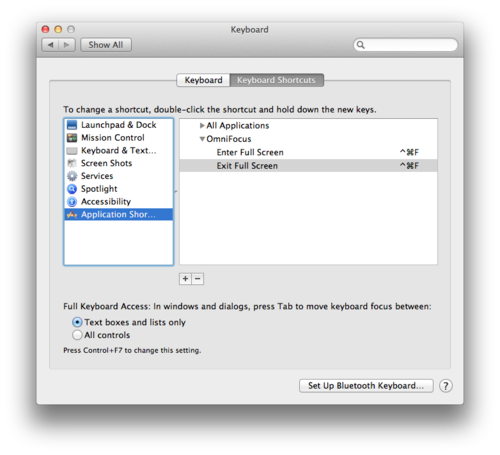
It’s been driving me crazy that Omnifocus doesn’t recognize ^⌘F to toggle full screen mode, so I created an application specific keyboard shortcut to handle this.
The only trick is that you need to create two shortcuts: one for ‘Enter Full Screen’ and one for ‘Exit Full Screen’. This is necessary because Omnifocus changes the menu text depending on the current mode.
Free VST Plug-ins from MDA
I was just playing around in Live with the MDA VST plug-ins (also available as AUs):
So far I’m impressed; they sound pretty decent.
Connecting a Camera to Max/MSP/Jitter
Andrew Benson over at the Cycling ‘74 site put together a really solid post on connecting a camera to your Max patch:
Making Connections: Camera Data
He covers the hardware requirements (cost, Quicktime drivers for mac users, and manual controls) as well as the handling you may want in your patch. What frame rate do you want to deal with? What are a few ways you could extract useful information from the feed?
127th AES Convention
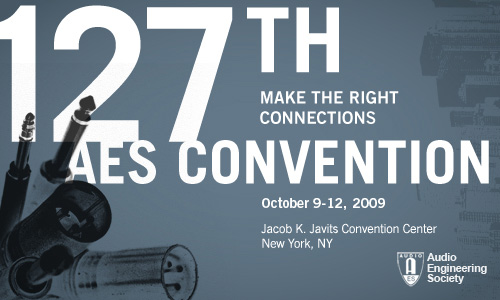 So it’s been a while since I’ve had a chance to post here, but I just got back from a weekend of AES and I need to report on the happenings.
So it’s been a while since I’ve had a chance to post here, but I just got back from a weekend of AES and I need to report on the happenings.
I made it down Thursday night and stayed until the end of the program on Monday: four long days at the convention and a great time catching up with friends both living in New York and visiting for the show.
If you haven’t been to an AES convention, they’re broken up into two distinct parts: a trade show, with equipment designers and manufacturers showing off their new products, and a technical session, where industry professionals and research can share their recent work. Usually you can cover the trade show in a day, though this year it took a lot less time. Through some combination of the economy and industry politics many manufacturers did not attend; I think the most conspicuous absence was Digidesign, since they usually have a huge booth with half hourly product demos. For me the highlights here included the Shure booth, where I got to check out their new ribbon mics and visit with old colleagues, and the Grace Design booth, where they were showing off their new 500-series preamps.
The technical program was a little quieter than usually, but much more lively than the exhibit floor. Some of my personal highlights were the Max for Live presentation, the Headphone and Earphone Measurement Tutorial, David Berner’s presentation on emulation of analog hardware in DSP, and a number of papers I had a chance to catch.
I’m planning to write a bit about some of the presentations I saw, so stay posted. Also, hopefully this will be the beginning of a more regular posting schedule.
Pro Tools – Shortcut of the Week (2009.07.27)
Pro Tools is a strong multi-track editing program, but unless you’re willing to drop some change on a custom keyboard, it can be tough to learn all the keyboard shortcuts. I’m featuring one a week in an attempt to highlight the tricks I find most useful.
Set and enable pre/post time roll: Option-Click with Selector before or after selection
This is a follow up to last week’s shortcut, and an easy way to adjust the pre and post roll times. Don’t forget that Command+3 will get you over to the Selector tool. Again, pre-roll is a great alternative to manually punching!